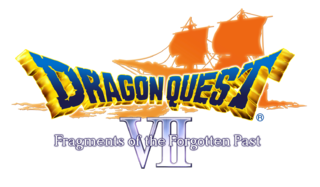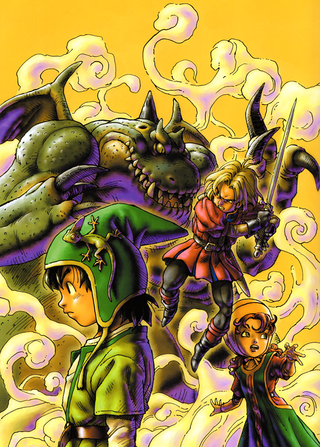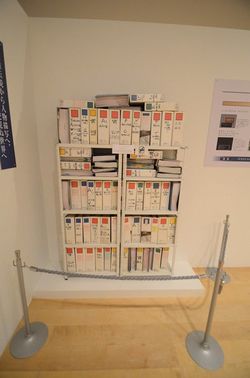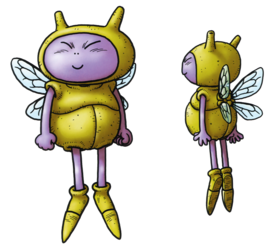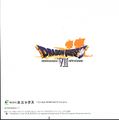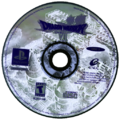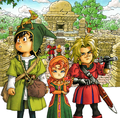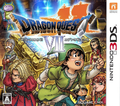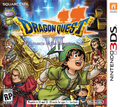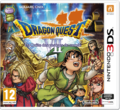Dragon Quest VII: Fragments of the Forgotten Past
| Fragments of the Forgotten Past | |
|---|---|
| Developer(s) | Heartbeat, ArtePiazza |
| Publisher(s) | Enix |
| Designer(s) | Yuji Horii |
| Artist(s) | Akira Toriyama |
| Composer(s) | Kōichi Sugiyama |
| Series | Dragon Quest |
| Platform(s) | Sony PlayStation, Nintendo 3DS |
| Release date(s) | PlayStationJP August 26, 2000 NA November 1, 2001 JP March 2, 2005 (PSOne Books re-release) JP June 20, 2006 (Ultimate Hits re-release) Nintendo 3DS JP February 7, 2013 NA September 16, 2016 EU September 16, 2016 AUS September 17, 2016 Android & iOS JP September 17, 2015 |
| Genre(s) | Role-playing game |
| Mode(s) | Single-player |
| Rating(s) | CERO: A (All Ages) ESRB: T (Teen) |
| Media | 2 CD-ROM, Game cartridge |
Dragon Quest VII (ドラゴンクエストVII エデンの戦士たち Doragon Kuesuto Sebun Eden no Senshi-tachi, literally meaning; Dragon Quest VII: Warriors of Eden) is the seventh installment of the popular Dragon Quest series of role playing games and the first in the series to not be a part of a larger trilogy. It was the first main series Dragon Quest title to be released outside of Japan since the release of Dragon Quest IV in North America in 1992, and the last title to be released in North America with the Dragon Warrior name.
The game follows the Hero and his friends as they discover secrets about the mysterious islands surrounding their isolated home of Estard, the only land mass in the entire world. Through some ancient ruins, they are transported to the pasts of various islands that used to exist and must defeat evil in each new location.
Setting[edit]
Dragon Quest VII is best known for its immense playtime. Without completing its side quests, a single game of Dragon Quest VII can take 100 or more hours. The main flow of the game is different than other Dragon Quest games; instead of exploring one large world, the party goes to separate continents by placing stone fragments into their appropriate pedestals in the Shrine of Mysteries. Once all of the missing shards are located and placed for a particular pedestal, the party is transported to the trapped location centuries in the past. After solving whatever problems plague the region, the party then travels back to the present. From there, they can travel via boat, carpet, or skystone to the modern version of the location they just saved. These saved lands appear on the main map, although the originals (from the past) can only be revisited through the ruins.
Plot[edit]
Characters[edit]
- Hero — The Hero's official default name is "Auster"; however, as is traditional in the Dragon Quest series, the name is supplied by the player (however, he is called Arus in the official manga). The Hero is a lifelong native of the town of Pilchard Bay on Estard Island. He is good friends with Maribel, daughter of the mayor, and Kiefer, prince of Estard Castle. In particular, he has a fondness for going out on impromptu "adventures" with Kiefer. It is one such adventure that begins the story of the game. In terms of gameplay, the Hero is a well-rounded character who will do well in any vocation.
- Kiefer — Kiefer is a prince of Estard Island, and the presumptive heir to the throne. Far from anticipating his elevation to kingship, however, Kiefer seems to resent his royal blood, and is a source of endless worry and frustration to his family and advisers. Kiefer, for his part, spends much of his time in search of excitement and adventure, and has found a kindred spirit in the Hero, whom he considers his closest friend. Kiefer is incredibly strong, with a high physical attack statistic and naturally high hit points. He is the most powerful character available early on in the game. On one trip to an ancient land, Kiefer falls in love, and remains behind. Upon returning to the present, the hero finds out that Kiefer has become a famous guardian of the Roamers, and is the biological ancestor of almost an entire culture/continent. Kiefer is also the main character of the game Dragon Quest Monsters: Caravan Heart as a young boy.
- Maribel Mayde — A friend of both the Hero and Kiefer, Maribel is the daughter of mayor Mayde. Unlike Kiefer, who has steadfastly refused to let his social status influence how he looks upon other people, Maribel tends to be very condescending towards others regardless of their social status. Despite this, she gets along well with her friends, and occasionally accompanies them on their adventuring, even if she sometimes has to pressure them into letting her tag along. Maribel is primarily a magic user: with low starting physical statistics, and an early lack of powerful weapons available for her use, it takes a good deal of time before she can do anything approaching the amount of physical damage inflicted by some of the other characters. On the other hand, Maribel has access to a variety of damaging attack spells relatively early on. In the remakes, she is capable of growing faster than even Ruff.
- Ruff — Although he appears to be a normal boy, Ruff is actually a white wolf pup who was irrevocably turned into a human. As such, he retains a number of obvious lupine characteristics, and can be somewhat bestial at times, though as a side effect of the Hackrobat attempting to cure him of his condition he can speak the human tongue well enough to be understood. He agrees to travel with the heroes hoping to protect his family from the demon king, but remains with the group out of a sense of loyalty. Despite his diminutive size and young age, he can easily become as powerful as the Hero, Mervyn, and Aishe through mastery of the the melee vocations. He is also very agile, though not as fleet-footed as Maribel.
- Sir Mervyn — A skilled paladin of centuries past, Mervyn fought on the side of The Almighty against the Demon Lord many years ago. Mervyn excelled at his work, and distinguished himself in both skill and honor. As such, Mervyn was petrified in stone by God, so that, should the need arise, he could be reawakened to once again take up the fight against evil. Mervyn joins the party after a lengthy revival process, although his age and unfamiliarity with the present day often leave other characters somewhat befuddled. Mervyn is proficient at both magic and physical combat, though his magic casting abilities are slightly superior to his physical attack skills.
- Aishe — Aishe is the lead ritual dancer of the Roamer tribe, an ancient race of people charged with the stewardship of a temple necessary in the act of calling forth God. Raised and trained at swordsmanship as well as gypsy dancing, Aishe is a more than capable fighter and will do well in any physically-oriented vocation. Although capable of doing both significant physical and significant magical damage, Aishe stands in contrast to Mervyn, in that her magic skills tend to lag slightly behind her physical statistics.
New features[edit]
Player conveniences[edit]
- Total play time is now marked next to save files.
- The ability to change message display speed and audio settings has been moved from the start screen to the in-game menu.
- All items can now be bought in bulk, not just weapons and armor.
- Brief descriptions of items are displayed when the cursor hover over them in the menu.
- 'The Big Book of Beasts' debuts, displaying monster actions, exp total, gold total, number defeated, and what item is dropped per species.
- If the player accidentally presses a button when there is nothing to interact with, no time-consuming message is displayed.
- When an item or gold is found, a small icon will appear over the protagonist's sprite along with the traditional jingle.
- The contents of bookshelves has been embellished, with hints for the area, anecdotal stories, and bad jokes found in several.
- A mimic for books has been added as well.
- Characters will typically move and gesture while speaking, making it easier to tell whom is talking.
Battle refinements[edit]
- The maximum value for all stats has been set to 999.
- Artificial intelligence strategies can be assigned to specific characters now instead of group-wide orders.
- Each character has a personalized A.I. that reflects their personality and influences their actions in battle. Maribel favors casting spells over using skills for one example; if she has learned Kaboom and Harvest Moon and her tactic is set to "Show No Mercy" then she will use the former whenever possible.
- The command menu layout for spells and skills have been split into three categories--Offensive, Defensive, and Other.
- Status buffs and debuffs for allies and enemies now expire after a number of turns, along with paralysis.
- Cursed equipment has been reinstated, requiring the use of a priest to remove.
- VII includes thirty-four Monster Vocations compared to the previous game's two, which can be unlocked by using the appropriate Monster Heart at the Alltrades Abbey or by mastering prerequisite monster forms. This allows a party member to transform into a monster during battle, gaining the resistances (and vulnerabilities) of that species.
- In the 3DS remake these vocations are often the only way to permanently learn excellent abilities.
The Haven[edit]
Returning from III, the boom town side quest has been reworked from a passive sequence to one the player controls directly. The Haven lets the player recruit people from various towns in the PSX Version, which changes depending on the type of people living there (e.g. several merchants will bring more stores to the town). In the 3DS remake the system is dependent on Traveller's Tablets after a brief tutorial, and the culture of the settlement is no longer variable. Additionally, all the inhabitants of the haven are reformed monsters instead of mundane folk, with the syntax of their past life carrying over into their current persona.
Party Chat[edit]
The ability to talk with the party members in and outside of battles was first added to the series in VII, adding a great layer of depth to each party member and setting a standard that would be continued in future installments. Party members will offer advice about battle strategies, remind the player about important plot points, or simply comment on how they feel at a given moment when this feature is used. The use of this feature adds considerable personality to each character, so much so that party chat was frequently used as a marketing device for remakes of older titles in Japan.
- Due to the tendency of party members reminding players what to do, the memory spells seen in VI and III have been removed.
Excellence Grading Organisation[edit]
The E.G.O. contests allow the player to compete for the highest stats, like the Best Dressed Contest from Dragon Quest VI: Realms of Revelation. Excellent equipment is awarded to anyone who can topple the reigning champions, two of whom are NPCs that can be found in the larger world.
Monster Meadows[edit]
The ability to catch monsters functions similarly to the Super Famicom Version of VI, although they no longer participate in battle. Instead, tamed monsters are sent off to a nature preserve called Monster Meadows: here the monsters can be seen in their natural environment and be interacted with in the same manner as human NPCs. Blueprints are found to add new environs to the park, allowing space for nearly every monster.
Development[edit]
Dragon Quest VII was directed by Manabu Yamana, with Shintaro Majima serving as the art director. Series veterans Yuji Horii, Akira Toriyama and Kōichi Sugiyama returned as designer, character designer and composer respectively. VII was designed to have a different feel from previous games, with a greater emphasis on puzzles.[1]
On January 15, 1997, development was announced to be in development for the Sony PlayStation, causing a rise in stock prices for both Sony and Enix in Japan.[2] By 2000, Dragon Quest VII was predicted to be so successful in Japan that it would "create a 50 billion yen effect on the Japanese economy", said research firm DIHS. [3]
Aspects of the game's presentation were decided as development advanced. In a June 1997 interview with V Jump magazine conducted alongside Akira Toriyama, Yuji Horii congratulated Squaresoft for the impressive visuals of Final Fantasy VII, marveling at how the pre-rendered backgrounds for each town maintained a distinct atmosphere and a high level of detail. When asked by Toriyama if Dragon Quest VII would also utilize pre-rendered backgrounds, Horii asserted that finding a presentation style best suited for his series was more important than pursuing graphical fidelity and that he wanted players to have the sensation of exploring the game's world on their own two feet [4]. In the same interview Horii stated that the monsters would be animated through traditional pixel art, expressing skepticism of rendering Toriyama's creations in 3D polygons. Horii cited the limited amount of polygons that the PlayStation could displayed on screen would leave monsters looking too blocky or flat; Toriyama himself chimed in and stated that a slime that looked blocky is not a slime at all [5]. Conversely the towns and dungeons are fully rendered in three-dimensional polygon graphics. According to Yuji Horii this offered the gameplay advantage of letting players freely control camera angles, whereas contemporary RPGs on the PlayStation only offered limited camera control (as in Capcom's Breath of Fire III) or static pre-rendered backgrounds of Square's Final Fantasy games. Horii also experimented with showing the party members in battle, but this resulted in there being less screen-space to display the monsters and that having to draw new pixel art for them at a smaller scale resulted in it being too difficult to discern their details [6].
At one point in 1997 Horii began playing the Japanese release of Diablo and was impressed by the gossip feature of the title, which gave NPCs multiple lines of dialogue not related to the main plot to enrich the atmosphere of the game [7]. Being inspired by Diablo and knowing the immense storage capacity of CD-ROMs were now at his disposal, Horii developed the party chat system to give the cast more defined personalities than had been possible during the cartridge days. Furthermore developing the party chat feature led to the creation of Maribel; the original scenario for the game's opening segment was having Kiefer be the only companion to the Hero, but Horii found that the prince's straightforward personality did not elicit the most interesting party chat dialogue. As such Horii wrote Maribel as a sharp-tongued teenager suitable for spicier dialogue and inserted her into the game at the beginning. The gossip system of Diablo was also expanded upon with in-battle party chat, where characters can weigh in on the situation and even give advice pertaining to specific situations.
The game's emphasis on solving puzzles was a result of Horii wondering if the series' tempo was beginning to grow stale after six games, as well as becoming fascinated with the 1993 puzzle game Myst. In order to give Dragon Quest VII a fresh experience compared to its predecessors, it was decided that the opening segment would consist entirely of solving puzzles rather than engaging in battle as soon as the player stepped outside of Pilchard Bay. The puzzle solving would persist through the remainder of the game for the individual scenarios as well as searching for the missing tablet pieces necessary to operate the Shrine of Mysteries [8]. As Horii would explain in a 2013 interview with the late Satoru Iwata, the development staff felt liberated by the storage capacity of CD-ROM technology and continued adding more and more scenarios to the game [9]. Horii and his team of five assistants ended up writing enough material to fill 16,000 A4-sized documents, which is the equivalent of 20 books [10]; 3,000 of those pages were party chat and battle conversations alone[11].
The game was delayed numerous times before its actual release. During a press conference held on March 13th, 1997 the planned release date was for the end of 1998, but it was delayed to the Summer of 1999 during a second press conference held on May 29th, 1998. The second delay would be announced in August of 1999, where the game was given a definitive release date of December 29th of that year; this date would be rescinded in November. A release window for Spring 2000 was announced during the Jump Festa 2000 event held in December of 1999, but this would also be rescinded in March 2000. The final release date of August 26th was announced in May. Work on the game was extended because the development staff wanted to perfect the game due to high expectations from the fans, and because the team only consisted of about 35 people. Before its release, it was ranked as the most wanted game in Japan and Square, knowing about Dragon Quest VII's release, moved its Final Fantasy IX game to come out on a later date to avoid competing directly with the title. Dragon Quest VII would be released on August 26, 2000 and hit a number of major sales milestones in Japan during it's initial release, becoming the highest selling PlayStation game in Japan at 4.06 million units sold, the best selling game of 2000 period, the sixth highest selling software title of all time by the end of 2000, and the highest selling title in the series until the release of Dragon Quest IX in 2009.
The English language localization of Dragon Warrior VII began directly after the game's Japanese release. Enix of America was tasked with translating over 70,000 pages of text via 20 translators and 5 copy editors, leading to inconsistent portrayals of main characters and several plot-holes. No effort was made to censor the context of the Japanese script, though considerable edits were made that change the tone of certain scenes. Additionally, nearly all dialogue for the monsters inhabiting the meadows was scrapped and replaced with new dialogue created by the localizers.
Development of the Nintendo 3DS version first began with transferring the documentation for the game into a digital format from the handwritten notes seen in the picture above, which took approximately one year. Producer Noriyoshi Fujimoto personally made the photocopies of each page to be archived digitally. Once this was completed and the information for the game could be readily accessed from at the click of a mouse, actual development time took approximately two and a half years. The largest structural change is in the beginning of the game, where the sequences of events that uncovers the ruins of Estard island is greatly streamlined to accelerate the beginning of adventure.
The 2013 remake for the Nintendo 3DS was localized in 2016 under the title Dragon Quest VII: Fragments of the Forgotten Past. It was translated by UK-based localization specialists Shloc Ltd, and adheres to the localizatio style set by Richard Honeywood and Plus Alpha. Square Enix originally had no plans to localize the title due to the size of text being cost-prohibitive compared to potential sales, but Dragon Quest fans of France began a letter writing campaign to bring the game overseas that reached the CEO of the company as well as that of Nintendo[12]
"“We actually had no plans of releasing it at first. It was because the text was so huge that considering [the] cost and time that went in, we didn’t think it was worth it. Actually a lot of core fans from France approached us, and then we received letters, not just us but the CEO of our company as well as Nintendo, and everybody else that was involved, requesting a localized version of Dragon Quest VII. They were even saying at one point that they’ll localize it themselves for us. Because of that high demand we realized we really had to do this thing.”"
—Yu Miyake, series producer
Soundtrack[edit]
As with every Dragon Quest, Kōichi Sugiyama composed the musical score and directed all the associated spinoff soundtracks. As a first for the series, the original sound version was bundled with the symphonic suite in a two-disc set called Dragon Quest VII: Eden no Senshitachi Symphonic Suite + OST. The entire first disc and the opening song of the second disc consists of the symphonic suite, while the rest of the second disc is the original sound version. A disc titled Dragon Quest VII: Eden no Senshitachi on Piano was also released, and contained 27 piano-arranged tracks. The Symphonic Suite was later reprinted by itself in 2006.
Reception[edit]
| Reception | |
|---|---|
| Aggregate scores | |
| Aggregator | Score |
| GameRankings | 81% |
| Metacritic | 78 out of 100 |
| MobyGames | 77 out of 100 |
| TopTenReviews | 3.20 of 4 |
| Review scores | |
| Publication | Score |
| Famitsu | 38 out of 40 |
| Game Informer | 6.75 out of 10 |
| GamePro | 4 out of 5 |
| GameSpot | 7.7 out of 10 |
| IGN | 8.7 out of 10 |
| Official PlayStation Magazine (US) | 4.5 out of 5 |
VII was very well-received in Japan upon release, though in recent years it has attracted a larger amount of criticism than is usual for the series. Dragon Quest VII won the grand prize in Digital (Interactive) Art Division at the 4th Japan Media Arts Festival in 2000, where the game was praised for being "...engaging without depending on a high degree of realism..." and "...well refined and artfully executed." The game also won four awards from the 5th Japan Entertainment Software Awards by the Association Computer Entertainment Supplier's Association (CESA), including Best Prize, Scenario Prize, Sales Prize, and Popularity Prize.
Sales of the North American version of Dragon Warrior VII reached about 200,000 copies according to The Magic Box, which was not nearly as stellar as its Japanese counterpart. Enix of America still expressed their satisfaction with the sales figures. Dragon Warrior VII met with mostly good reviews from North American critics. IGN noted that all "100+ hours" of the game are enjoyable despite the dated visuals and clunky presentation. GamePro questioned whether the game's package was nostalgic or just awful, but still gave it a decent score and called it a great game overall. GameZone.com praised the game's concept and nostalgia factor and cited it as "what role-playing games were meant to be." They also noted the game's high difficulty, which, instead of making the game frustrating, they say, "make it that much more of an accomplishment when you complete a quest." IGN described the game's class system as "one of the best class systems seen outside a strategy RPG."
Other critics were not as pleased with VII: GameShark.com described the first two hours of the game as "some of the most boring hours you will ever play in a video game." XenGamers.com also pointed out that in order to play the game, the player needs "the patience of a rock". Game Informer even went as far as to say that "four million Japanese can be wrong", referring to the game's immense popularity in Japan.
Because of the game's delay in being developed, its release was after the PlayStation 2's release, which created some negative feedback, particularly about the game's graphics. IGN commented on this, calling the game "a game that makes only a bare minimum of concessions to advancing technology, but more than makes up for this with its deep gameplay, massive quest, and sheer variety." Gamespot called the graphics "not good" and warned readers that if the "most rewarding things" they "got out of Final Fantasy VII were the full-motion video interludes, you definitely won't be wowed by anything you see in Dragon Warrior VII."
Since the game's release, the most notable and consistent points of contrition among fans have been the lackluster graphical presentation, and the exploitative nature of the vocation system. Of particular note is the abundance of redundant skills and spells available to the earlier careers (Focus Strength & Muster Strength, Shove & Heave-ho, Muscle Dance & Roundhouse Kick, etc), along with a distinct imbalance between the usefulness of spells compared to skills. Coupled with this is the fact that, by having only three top tier vocations, the five party members will invariably share similar abilities and thus negate their individuality. Indeed, the glut of abilities was one of the primary motivations for the creation of VIII's weapon-specific skill trees, which have become the standard of the series ever since.
Remakes[edit]
Nintendo 3DS[edit]
The 3DS remake presents the game in full 3D with polygonal models replacing the PS1 version's sprites. The game has received the most modification of any remake or port in the series thus far, reworking the entire opening section to streamline the introduction to the story and characters to the point that approximately two hours have been removed. Additional conveniences and modifications have been implemented to remove the tedious nature of finding fragments.
- A radar has been added to make finding the stone shards easier than ever. A new character stationed in the Divine Shrine has also been added that gives players hints to finding them as well.
- Streetpass stones, a place in the immigrant town to go online to trade them with other players. Bringing streetpass stones to the immigrant town unlocks new dungeons, and special story scenes. Players can also get Streetpass Stones by making a party of monsters from the monster park and sending them into a special randomly generated dungeon.
- Party member appearance change immediately after switching vocations, with designs being made for several vocations for the first time.
- Party member appearance also changes immediately for monster vocations, not just upon rank 8 mastery like in the PS1 version.
- Weapons and shields are displayed in battle, some of which are animated.
- Vocation ranks require fewer battles to advance, with some losing as much as 40% of their mandate.
- Spells/skills for second and third tier vocations are only usable when in that class, giving the last part of the main game more balance.
- Overall simplification and re-balancing of which vocations get which skills, including elimination of the hybrid skill system. The skills in question have not been removed, however, and are now available through normal vocation advancement.
- Maribel now learns the Bang spell naturally, making the scenarios prior to unlocking the vocations easier.
- The Tidal Wave skill has been removed in response to the Kanto Earthquake disaster of 2011. Enemies that used the skill now use Jolly Rager instead, with the damage range lowered to that of Tidal Wave's for balance.
Dragon Quest VII Reimagined[edit]
An HD remake titled Dragon Quest VII Reimagined was announced on September 12th, 2025. Unlike the Nintendo 3DS remake, this iteration is a complete reworking of the experience that fundamentally changes the nature of the game.
Related media[edit]
The manga adaptation of Dragon Quest VII was published by Enix's Monthly Gangan in Japan. It was illustrated by Kamui Fujiwara, who also worked on another franchise-related manga, Dragon Quest Retsuden: Roto no Monshō. Fourteen volumes were released between 2001 and 2006 until the series was cancelled, and a canonical sequel titled Dragon Quest Ending began serialization in Square-Enix's Young Gan-Gan magazine on January 5th 2026.
In this adaptation, the hero is given the name "Arus". The manga follows the game story while adding in new characters and more detailed relationships, as the original hero was silent and a personality needed to be added for the comic version.
Credits[edit]
| Role | Staff |
|---|---|
| Scenario & game design | Yuji Horii |
| Character designer | Akira Toriyama |
| Music composer | Kōichi Sugiyama |
| Director of programming | Manabu Yamana |
| Art director | Shintaro Majima |
| Scenario | Yuji Horii, Sachiko Sugimura, Fuminori Ishikawa, Kazunori Orio |
| Programming | Manabu Yamana, Masayuki Kawamoto, Yasushi Watanabe, Hiroaki Suzuki, Hajime Ito, Makoto Hirashima, Yoshihiro Matsumoto, Yasuhiro Yoshida |
| Graphic design | Shintaro Majima, Hiroshi Muroki, Naoyuki Hayakawa, Tatsuya Takahashi, Yukari Umada, Masato Hirayama, Ruri Yamaguchi, Yoshihisa Nishimura, Rena Konaka, Keiichi Egawa, Kohei Matsushita, Katsuhiko Shiono |
| Graphic tool programming | Takeshi Sugimura |
| Sound design | Tsukasa Tawada |
| Monster Design | Katsuyoshi Nakatsuru, Osamu Kaneko |
| Localization Programming | Hiroaki Suzuki |
| Translation | (Wordbox Inc.) Lucie Ishii, Hiroko Yoda, Jeff Gelbard, Wayne Lammers, Matt Alt, Jeremy Blaustein, Ryan Morris |
| Role | Staff |
|---|---|
| Localization manager | Mitsuru George Torii |
| Product manager | John Laurence |
| Quality assurance lead | Jon Weisnewski |
| Copy edit | Chris Chymiy, Dustin Brown, Doug Hill, Sean Peters, Mike Tidwell |
| QA translation | Masanobu Yoshida, Katsuko Bandur, Hisayo Tomiyama, Miki Yasui Marr |
| Play testers | Zeb Clinton, Shawn Conard, T. J. Cowgill, Bryce Felt, Matthew A. Gillikin, Eric Ho, John Holes, Eric Junge, Ed Price, Jerry Pritchard, David Rieman, Dylan Sharp, Tom Shultz Jr. |
| Sales & marketing manager | Andrew Stein |
| Accounting & credit manager | Misuzu McMillan |
| A/R analyst | Yuri Kato |
| Administrative assistant | Emi Coughlin |
| President | Paul Handelman |
| Role | Staff |
|---|---|
| Technical Support | Kenjiro Kano, Tomoyuki Iwai |
| Play testers | Satoshi Sato, Hideyuki Nukui, Satoru Kubota, Joe Mitsuta, Takayuki Mibu, Iiro Kimura, Rie Iwao, Masaki Murashita, Shinobu Nonaka, Mika Endo, Takatoshi Akiyama, Ryuichi Nakamura, Mie Ohnishi |
| Artwork | Naoki Oishi, Takashi Kamimura, Arte Piazza |
| Public relations | Yū Miyake, Ryoichi Kuramochi |
| Special thanks | TamTam |
| Localization coordinators | Daisuke Kobayashi, Jun Miyamoto, Yoshito Taniuchi |
| Producer | Taichi Inuzuka |
| Executive producer | Yukinobu Chida |
| President | Keiji Honda |
Gallery[edit]
Dragon Quest Ending promo art with an adult Kiefer
References[edit]
- ↑ "Dragon Quest VII Interview". RPGamer.
- ↑ "Enix/Sony Update". IGN. January 16, 1997.
- ↑ https://web.archive.org/web/20181119011003/https://game.watch.impress.co.jp/docs/20010109/enix.htm
- ↑ 堀井: 自分の足で歩いている感じがする新フィールドにしたいな 堀井: 「FFVII」の背景の絵はすごかったですね。細かい所まで描きこんであって、町ごとにいろんな雰囲気がある。どこに入れるんだろう、ここはどうなっているんだろう、と思って歩き回りました。 鳥山: 僕も初めて見たときは、とにかくビックリしましたね~!! RPGのグラフィックもここまで来たか、と思いましたね。DQはどうなるんですか? 堀井: ハードが変わって、技術的な面でやれることが増えたんですが、どれがDQに合っているのか、ということを考えてプログラムをする必要があると思うんです。ほのぼのした味を残しつつ、自分の足で歩いている感じが出せたらいいですね。
- ↑ 堀井: ポリゴンにすると、画面に表示できるポリゴンの数に限りがあるでしょ? カクカクとか、ノッペリしちゃったりして、鳥山さんの絵がいきない。 鳥山: スライムがカクカクしてたら、スライムらしくないですからね。キャラも冷たい感じがするし。
- ↑ 鳥山: やっぱり戦闘画面に自分がいないんですか? 堀井: 実はそこが悩みどころでね。今いろいろ検証中なの。自分の姿を見せると画面が小さくなって、モンスターが小さくてわかりにくくなるんですよ。
- ↑ — 『VI』では自分捜しの旅でしたが、『VII』ではどんな旅に? 堀井: 仲間が重要になってきます。 富田: おー、仲間ですか? 堀井: 仲間をより仲間らしく。パソコンゲームの『ディアブロ』など、通信で生身の人たちと遊ぶゲームが、最近人気ありますよね。その感覚を出せないモノかなって思ってるんですよ。 富田: 生きてる相手とコミュニケーションをとるようなゲームですか? 楽しそうですね。 堀井: 実際に人間といっしょに旅をしてるんだっていう感覚。オンラインじゃないので、どこまで実現できるかわからないですけど、そのためにいろいろシステムを考えて、膨大な量のデータを用意してるんです。でも、やっぱり容量的にも時間的にも限りがありますからね(笑)。 富田: どんなゲームになりそうですか? 堀井: エンディングを見て「いい話だったなあ」って言うゲームよりも、やってるときが楽しいゲームにしたいんですよね。ストーリー重視だと早く終わらせようとするけど、「まだ終わりたくない、ずっと遊んでいたい」というゲームにしたいですね。March 6, 1998 issue of Famitsu
- ↑ 岩田: 堀井さんが『VII』の オリジナル版をつくった時、 容量が増えてできたこと以外の 新しいチャレンジとして、 どんなことを盛り込まれたんですか? 堀井: ボクは当時、『MYST』という 海外のアドベンチャーゲームが気に入っていて、 「こんな謎解きもおもしろいな」と思っていたんです。 というのも、その頃は 「みんなレベル上げの戦闘に飽きてきたんじゃないか?」 という思いが、ちょっとあったんですね。 岩田: たしかに、RPGの序盤は、 「とりあえずレベル上げしておこう」 みたいなところが、 当時のお約束になっていましたからね。 堀井: そこで『VII』は、ゲームをはじめると 謎解きをメインに展開する構成にしたんですね。 だから冒頭の5時間くらいは、 戦闘なしで物語を進めるというふうに。 岩田 :ああ、あれは『MYST』の 影響を受けていたんですか。 堀井: はい、やってみたかったんです。 まあ、いま振り返ると 「あれは必要だったかな?」とは 思いますが(笑)。https://www.nintendo.co.jp/3ds/interview/creators/vol24/index2.html
- ↑ 堀井: あのときはじめて『ドラクエ』を CD-ROMメディアでつくったんですけど、 「とにかく容量が多く入る」ということで はりきって、つくりすぎちゃったんです。 岩田: 制限から解き放たれた人たちが やりたかったことを表現しようとしたのが、 『VII』の歴史なんですよね。 藤本: スクウェア・エニックスに 歴代の『ドラクエ』の仕様書が保管されているんですけど、 『VII』はほかのナンバリングよりも圧倒的に多くて 「これ、ほとんど『VII』なんじゃない?」 というくらいの量があるんです。 しかも資料がぜんぶ、紙なんですよ。 堀井:『VII』までは、紙に手書きでシナリオを書いて、 データとかもすべて紙上でつくっていました。 岩田: 時代を感じますね。 堀井: ちょうどシナリオスタッフを増やした頃で 毎週、スタッフからこのくらいの (人差し指と親指をいっぱいに広げて) シナリオが送られてくるんです。 それを一言一句読んで、修正を延々やって・・・。 あの時は毎日つらかったなあ。 一同:(笑) 藤本:1日に数百枚のFAXをやりとりするので、 機械がしょっちゅう故障したそうです。 https://www.nintendo.co.jp/3ds/interview/creators/vol24/index.html
- ↑ ――現在はどのくらいのスタッフでプロットを考えているのですか? また、ゲームを制作する上で大切だと思うことは何でしょうか。 プロットは僕自身で考えていますが、だんだんゲームが大きくなってきたので、実際の細かいセリフなどでは、『ドラクエIV』あたりから何人かのスタッフに協力してもらっています。『ドラクエVII』は5人が参加していますね。なにしろ、シナリオだけでA4の紙に1万6000ページくらいある。8センチファイルで20冊分に相当する分量です。とても1人で書けるレベルじゃないですよね。ゲームの制作そのものは、しだいに分業制になっていって、『ドラクエVIII』でも総勢200人以上という規模になっています。制作期間も長くなって、1つのゲームをつくるのに4〜5年かかるようになりました。https://web.archive.org/web/20100614061622/http://plaza.bunka.go.jp/museum/meister/entertainment/vol2/
- ↑ 戦闘の見どころは? — 戦闘の見どころを教えてもらえますか? 「『VII』の大きな特徴のひとつが戦闘ですね。戦闘はモンスターがすごく動きます。ひとつの行動についてひとつのアクションを持っているくらいですから、見ていてあきないですね。それでいてテンポをよくしました。すごく気持ちのいい戦いができるように設定しています。(※5) それから、これがいちばん大きなウリなんですけど、実は戦闘中も仲間と話ができるんです。たとえば〝オレは弱っているからホイミをかけてくれ!"とか。実際に友だちといっしょに戦っているような感じがあると思います。(※6) 実はですね、『VI』のシナリオは、紙にして全部で4000ページぶんくらいあったんです。で、『VII』のシナリオは1万6000ページあって、そのうち3000ページが仲間のセリフなんですね。(※7) 仲間のセリフだけで『VI』全体の4分の3に相当する量なんです。これ、言っちゃっていいのかな(笑)。そういう、ぼう大なゲームです」V Jump March 2000 interview
- ↑ "Why Dragon Quest VII 3DS Took So Long to Come West". Kotaku. June 17, 2016.
